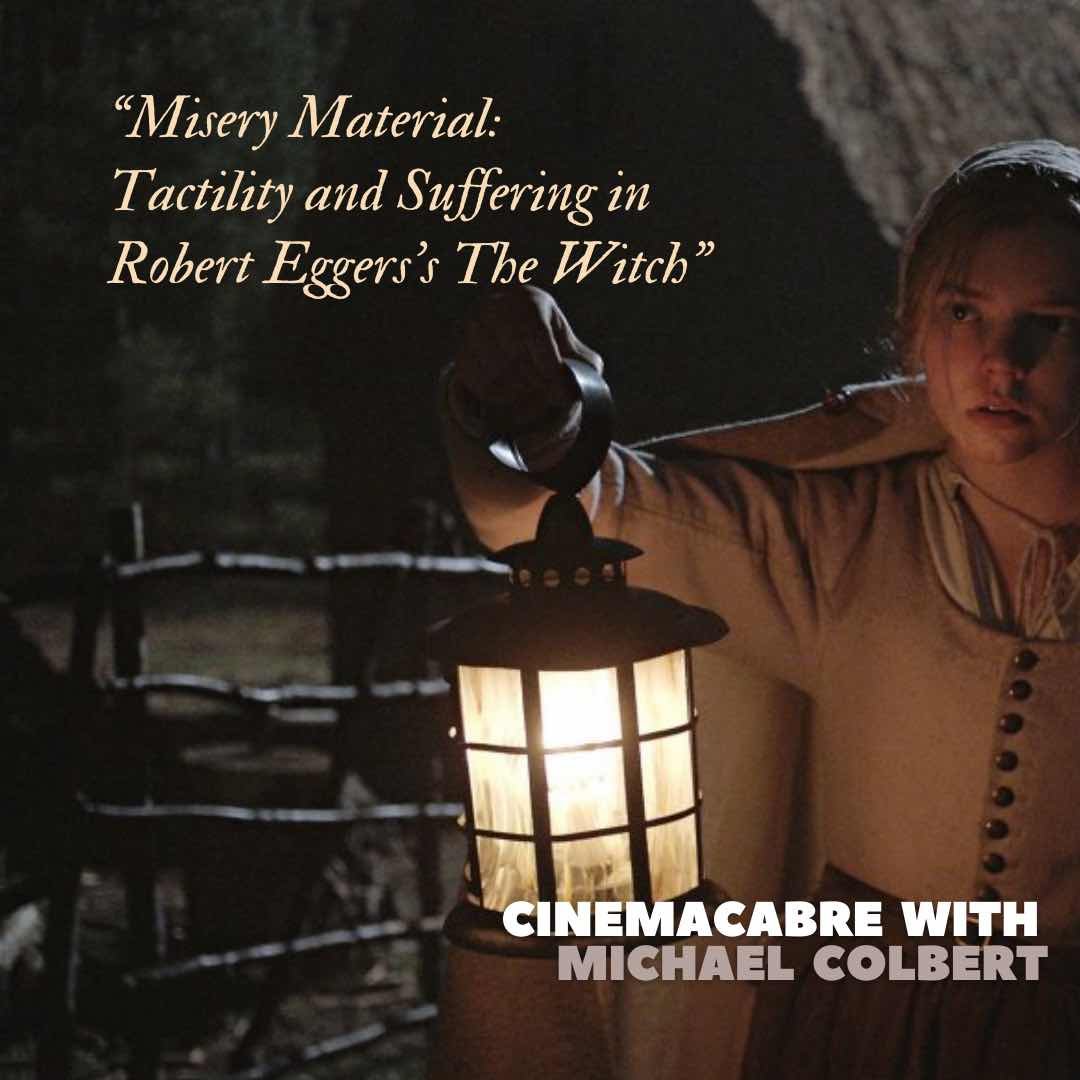Misery Material: Tactility and Suffering in Robert Eggers’s The Witch
Robert Eggers’s The Witch dramatizes the family’s dissolution and the drudgery of early Massachusetts with Pantone’s 2021 color of the year — Ultimate Gray.
The film cuts the family loose to begin. The camera tracks the family traveling from civilization to an expansive nature: barren trees and hilltops, dissonant string music foreboding beneath. The land is bigger than its inhabitants. It can swallow them whole.
As uncanny as the resemblance is to the opening of Stanley Kubrick’s film, The Shining — roads cut through forests and into mountains, shots that glide over a glassy lake to brooding organ music — this landscape belongs to the Massachusetts of Robert Eggers’s 2015 film, The Witch. A self-proclaimed “New England Folktale,” The Witch tells the story of a family of Puritan settlers exiled from their home. The film opens on the face of a young Thomasin, played by a twenty-year-old Anya Taylor-Joy, holding her breath through the family’s hearing. So ardent in his practice of Christianity that he has agitated to extremity, the father, William, commits the family —his wife, Katherine, and five children — to a life of exile. The scene cuts to brooding vistas, and then, all of the sudden, they blur into the dimly-lit wilderness.
The opening of The Shining establishes the predominance of the landscape to then pinpoint the tininess of the Torrance family within it. Similarly, The Witch unleashes a precarious family unit into an environment they cannot prepare for, offering a New England answer to the 1970s family horror in the Overlook Hotel. Yet, while the camera follows the Torrance family barreling into the mountains, in The Witch, the gaze is stationary, anchored to the community they’re deciding to abandon in the name of a prideful banishment.
⦿
Immediately, the family’s misery intensifies. Thomasin plays peekaboo with baby Samuel outside. The camera cuts between their faces, and then it holds her gaze too long, tracking the dread of a discovery withheld from the camera: Samuel is gone. She looks off to the woods. They claim a wolf, fear witches. The family fractures through this loss. Baby Samuel has gone to hell.
This deluge of misery is not uncommon. In The Shining, the family encounters more supernatural horrors and familial strife the longer they commit to life in the outpost of the hotel. With careful attention to costuming, The Shining offers a critique of the entitlement of a western Americana, of their belief this hotel might be a beacon for their family. The Torrances appear in critical moments wearing red and blue. In the film’s screaming climax, Jack Torrance stalks his wife and son dressed in Levi’s and a red corduroy overshirt.
The Witch dramatizes the family’s dissolution and the drudgery of early Massachusetts with Pantone’s 2021 color of the year — Ultimate Gray. Their world is unsaturated, overwhelmed by dead grass, cracking corn stalks, barren treetops, and oatmeal-colored clothing. The film pays close attention to these tactile details, drumming up the anxiety and futility surrounding their mission through touch. Shortly after Samuel disappears, Thomasin spies on her mother, and hanging fabrics obscure the camera’s gaze on her. Shots are framed by cloth hats, as if the camera is breathing down Thomasin’s shoulder. Banished from their colony, unable to grow food and hunt, the family is running out of options, and their desperation is so acutely felt through the film’s palette and texture.
Thus feeling such desperation, they turn to god and talk of witchcraft. There’s something overwhelmingly futile to what they’ve set out to do. William elected for banishment instead of an understanding of god that might find accord within their colony. He chooses doom for everyone, and, frustrated by their new isolation and subsequent losses, chops wood. Many of the family’s conversations revolve around their corrupt natures, the loss of Samuel to hell. Katherine wishes they could return to England and obsesses over her father’s silver cup, an heirloom, a physical object that might provide some material comfort through this mission.
Inside the dark of the home at night, the family is often framed like an El Greco painting: dark clothing, darker backdrops, long-faced parents (in both senses of the word). There’s a severity to the home, a constant discord felt each night. The parents fight. They’re convinced the family is cursed. They should never have left. Their son is in hell, they’ll all starve, and the kids listen, forlorn, upstairs.
Though they fret about hell, the film portrays their current state as a gray purgatory. Color appears in their world only once the witch appears. In a familiar move, red shocks into the film in dramatic moments — red of temptation, of danger, seduction. Thomasin milks a goat and draws blood from the udder, a sign of the curse, a sign of starvation to come. Desperate for food, Caleb chases a rabbit into the woods. He ends up at the witch’s cottage. She slinks out in a red cape, framed like the cover of a fantasy erotica novel with her corset and low neckline and thatched roof home. Caleb returns to the family, shivering and naked. They try blood-letting to draw out the sickness and witchcraft. They cut his jaw, sealed shut, and he spews a rotten apple, so crimson against the gray house it appears candied. The film flaunts its play with color, sometimes quite obviously. The family’s black ram, named aptly Black Philip, is, in fact, Lucifer incarnate. The young twins cajole Black Philip, singing, “Black Philip, Black Philip tonight the queen is red.”
Through all of this, the film betrays the family’s masochism. They receive ample warnings to relent, recant, seek help, but instead inflict more suffering upon themselves by adhering to this mission. As the parents convince themselves of the wickedness of their children, fractures open for the evil of their environment to claw them apart. In moves befitting puritanical, contrapasso hell, the parents suffer at the hands of the bewitchers. In a vision, Katherine believes she’s breastfeeding her son Samuel, but through a series of cuts between the house and the barn where they’ve trapped the children with Black Philip, a crow is revealed, pecking her breasts. The next morning, Black Philip gores William into the pile of wood he’s fervently chopped.
The film offers at once a punitive and sympathetic vision. While they work by the riverside, Caleb glances down Thomasin’s shirt. Later that day, the witch enchants him into her clutches through a seduction that Caleb, tight-lipped, refuses to meet. Thomasin, the nexus of anxiety as a witch-aged girl, appears sympathetically as well. This narrative is one we’re familiar with. She’s a girl out of options, her fate narrowed by her parents’ choices and subsequent insistence upon her wickedness. Thus, each appearance of color offers a glimpse into an alternative lifestyle for her. Yet, this is not so radical. Of course color can be manipulated in this way.
Coupled with its attention to textures, The Witch more organically conveys an unbounding of joy. After axing her mother in a struggle for her life, Thomasin returns inside the home. In one shot, she unlaces her dress and strips to her slip. The fabric falls from her body and pools at her feet. Thomasin unstitches herself from this oppressive life. Now, Black Philip rustles from goat to human. Bells jingle. The pages of his book unpeel so sensually. Suddenly, sound evokes the material more sweetly, so sensually. Suddenly, the barn is dappled with blacks and reds and whites. Black Philip encourages her out of her slip. She walks naked into the light of the fire, so overjoyed by this light, this new world, that she cannot help but join the other witches and rise into the sky.

